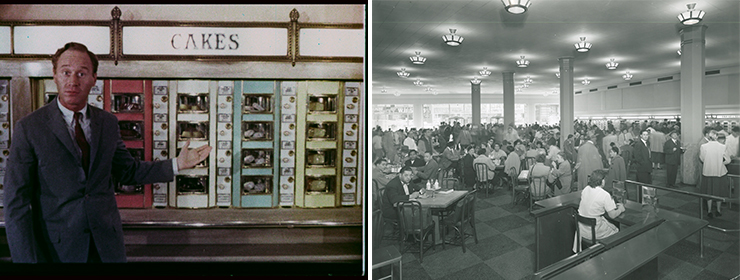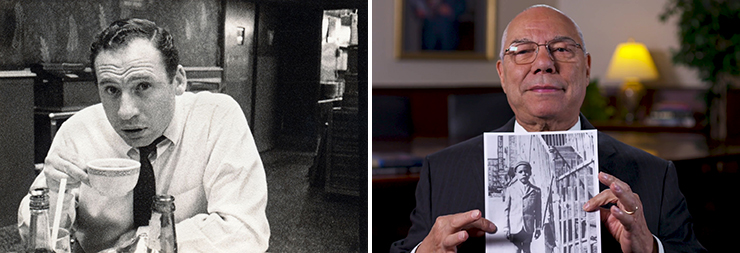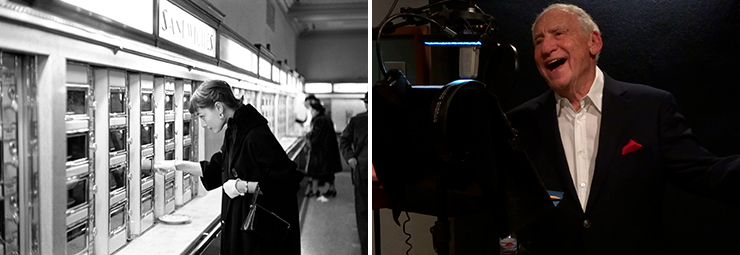
LEFT: A Horn & Hardart television commercial. (Photo courtesy of A Slice of Pie Productions.) RIGHT: The Automat. (Photo courtesy of The New York Public Library Robert F. Byrnes Collection of Automat Memorabilia)
You may have spotted them in older movies. Maybe you've been around the block long enough to remember seeing them in person. Those small windows with knobs gave diners a tantalizing view of a mouthwatering dinner entrée, or maybe a scrumptious sweet treat. All it took was a nickel, or two, for you to dig into that hearty goodness. Even if you're a newbie, it's hard to deny the appeal of the Horn & Hardart restaurants that popped up in Philadelphia and New York City at the dawn of the 20th century.
“The Automat,” a new documentary tracing the history of this fruitful business partnership and the seismic effect it had on the zeitgeist for decades, is awfully fond of the good old days and is not the least bit ashamed to admit it. On paper, it sounds like business as usual: an assortment of archival footage and talking heads, speckled with some vérité moments. But director Lisa Hurwitz's affectionate portrait, which dashed off with the audience award for Best Documentary at this year's Miami Jewish Film Festival, largely amounts to more than the sum of its parts, because of the way Hurwitz uses these traditional elements to craft what often comes across as a scrapbook in motion.
 RIGHT: Colin Powell holding up a photo of himself taken circa 1943 in "The Automat." Photo courtesy of A Slice of Pie Productions." />
RIGHT: Colin Powell holding up a photo of himself taken circa 1943 in "The Automat." Photo courtesy of A Slice of Pie Productions." /> LEFT: Mel Brooks photographed by Carl Reiner, circa 1950-1954, in "The Automat." Photo courtesy of A Slice of Pie Productions.
RIGHT: Colin Powell holding up a photo of himself taken circa 1943 in "The Automat." Photo courtesy of A Slice of Pie Productions.
It begins in present day, with a visit to a storage space housing some of those nifty food displays that turned dining out into an egalitarian experience that brought together people from all walks of life. It's mind-boggling to see something that was such a pervasive part of so many people's lives stacked together like artifacts from another civilization.
So what was it like to visit the Automat? To answer that question, Hurwitz enlists Mel Brooks to take on a sizable part of that task, and one of the perks of this briskly paced film is that it also works as a stealth biography of the filmmaker and funnyman. Even in his mid-nineties, Brooks has more pep than many people half his age. It comes as no surprise that the Oscar winner is a mensch, but he's also a vivid raconteur. His accounts of going to the Automat with his family give dynamic flair and a distinctive flavor to what could have easily been a dry, just-the-facts affair. “You needed a lot of nickels, but you didn't need a lot of money,” he says at one point. How committed is the “Blazing Saddles” and “Spaceballs” director to this project? He even composed a song for it.
Brooks' stroll down memory lane goes hand in hand with a judiciously assembled chronicle of the rise of Horn & Hardart, thanks in large part to a wealth of photographs and newspaper clippings, coupled with interviews with self-described Automat historian Alec Shuldiner. Viewers also get to hear from the founders' descendants, who have their own stories to tell about Philadelphia's own Joseph Horn and New Orleans-based Frank Hardart, and how they took a chance and joined forces. What ensues is an absorbing tale of the virtues and drawbacks of capitalism.

LEFT: Supreme Court Justice Ruth Bader Ginsburg in "The Automat." (Photo by Steve Cochlin) RIGHT: Starbucks CEO Howard Schultz holding a framed Automat picture that hangs in his office, in "The Automat. (Photo courtesy of A Slice of Pie Productions)
What's missing, despite the considerable skill Hurwitz, writer/editor Michael Levine and fellow editor Russell Greene bring to the table, is a glimpse at these moguls' personal lives. For example, one interview subject mentions Horn didn't have any children, and that tidbit just hangs there for a second before the film simply moves on. There are advantages to being an estate-friendly profile of this company and the men who ran it, but one cannot help noticing we are kept at arm's length in some aspects.
But what “The Automat” lacks in personal intimacy, it compensates in its curiosity for the nuts and bolts of keeping these European-inspired eateries running smoothly. It captures the sense of wonder diners must have felt when they walked through those doors, dropped nickels in the slots and opened the glass windows to help themselves to steaming plates of Salisbury steak, baked beans or creamed spinach, then topped it off with a slice of lemon meringue, all thanks to Machine Age technology and the tireless workers behind the displays. Hurwitz also doesn't shy away from delving into the Depression-era unrest that led to labor strikes that, the founders' relatives point out, thankfully did not affect the Horn & Hardart locations due to the care given to their workforce.
The film seamlessly glides back and forth between its history lesson and the personal anecdotes, incorporating multiple first-hand accounts, including from two late political trailblazers from opposite sides of the aisle: Supreme Court Justice Ruth Bader Ginsburg and former Secretary of State Colin Powell. Their stories aren't as fun as Brooks', but they shed light into how the Automats opened their doors to everyone, a rarity for a kid from the South Bronx like Powell, and how they were a microcosm of American society at the time. Breezy conversations with Carl Reiner, Brooks' longtime friend and collaborator, and actor Elliott Gould are the cherry on top.

LEFT: Audrey Hepburn in the Automat, New York City, 1951. Photo by Lawrence Fried. RIGHT: Mel Brooks recording his original song "At the Automat," in "The Automat." (Photo courtesy of A Slice of Pie Productions)
Hurwitz keeps the momentum going as long as she can, but “The Automat” does run out of steam with about 20 minutes left to go, when it goes into the bad managerial decisions and changing social trends that conspired to bring about the Automats' eventual demise. The filmmaker also includes an interview with Starbucks CEO Howard Schultz, who waxes nostalgic about the influence the Horn & Hardart locations had on the birth of his coffee empire. The parallels between both companies are understandable, but they're more than a tad on the idealistic side.
But at 79 minutes, the end result is still a pleasant watch, a sunny celebration of all-American gumption anchored by a melancholy undertow. “The Automat” is unabashedly sentimental, but it dives into its subject with eyes wide open. It trades in no-nonsense nostalgia.
“The Automat” is showing this week only at AMC Aventura and is ongoing at the Movies of Delray multiplex.




